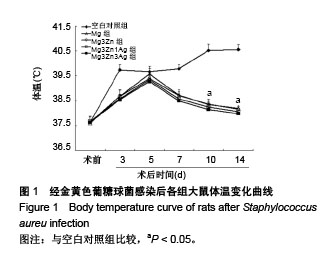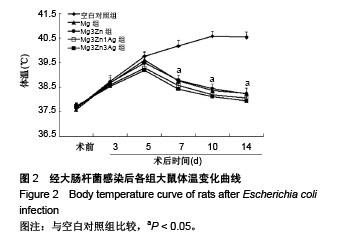• 组织工程骨及软骨材料 tissue-engineered bone and cartilage materials • 上一篇 下一篇
植入体内新型镁合金材料的抗菌性能
王 湛,杨 军,李建军
- 中国医科大学盛京医院创伤骨科,辽宁省沈阳市 110004
Antibacterial properties of novel magnesium alloys in vivo
Wang Zhan, Yang Jun, Li Jian-jun
- Department of Trauma Orthopedics, Shengjing Hospital of China Medical University, Shenyang 110004, Liaoning Province, China
摘要:
文章快速阅读:
.jpg)
文题释义:
骨内固定材料:对骨折的治疗方法中固定是至关重要的,目前采用的骨折内固定材料主要有金属材料、有机高分子材料、生物陶瓷等。其中,金属材料以其机械强度较高、具有一定的硬度及具有耐腐蚀性和较好的生物相容性而被广泛应用。
医用镁合金材料:镁是是构成人体的常量元素,参与体内的多种生物反应过程,无毒无害,镁合金材料即以一定的比例加入了镁、锌和银,既提高了材料的机械强度、韧性又加强了促进组织修复、骨折愈合的功效,而且由于可降解特性避免了二次手术。
背景:新型镁合金具有良好的生物安全性、可降解性及良好的机械强度与生物相容性,作为新一代医用金属材料受到瞩目。目前国内外对镁合金的研究主要集中于降解的过程及机制、生物安全性、生物相容性等方面,关于其抗菌性能的研究较少。
目的:观察新型镁合金材料(Mg3Zn、Mg3Zn1Ag、Mg3Zn3Ag)的体内抗菌性能。
方法:取15只SD大鼠,在其后肢胫骨内分别植入镁及镁合金材料(Mg、Mg3Zn、Mg3Zn1Ag、Mg3Zn3Ag),每种材料3只,在切口处注射金黄色葡萄球菌菌液,设置单纯注射金黄色葡萄球菌菌液的空白对照组;取15只SD大鼠,在其后肢胫骨内分别植入镁(Mg)及镁合金材料(Mg3Zn、Mg3Zn1Ag、Mg3Zn3Ag),每种材料3只,在切口处注射大肠杆菌菌液,设置单纯注射大肠杆菌菌液的空白对照组。植入后连续14 d监测大鼠体温;植入后第1,3,5,10,14天检测血白细胞计数;植入后第14天处死大鼠,取手术部位分泌物及组织,进行细菌种类鉴定。
结果与结论:①经金黄色葡萄球菌或大肠杆菌感染后,各组大鼠体温均上升,但植入镁及镁合金组大鼠体温始终低于空白对照组;并且随着镁合金材料中Ag含量增多,动物体温升高幅度减小;②经金黄色葡萄球菌或大肠杆菌感染后,空白对照组大鼠白细胞数量持续升高,植入镁及镁合金组大鼠植入后第5天白细胞数量最多,此后各检测的时间点的白细胞数量均显著低于空白对照组(P < 0.05),并且随着镁合金材料中Ag含量增多,白细胞数量升高减少;③金黄色葡萄球菌感染模型组细菌培养呈金黄色葡萄球菌(+);大肠杆菌感染模型组细菌培养呈大肠杆菌(+);④结果表明,新型镁合金材料植入体内对金黄色葡萄球菌或大肠杆菌感染具有明显抑制作用。
ORCID: 0000-0002-3488-9421(杨军)
中图分类号:




.jpg)